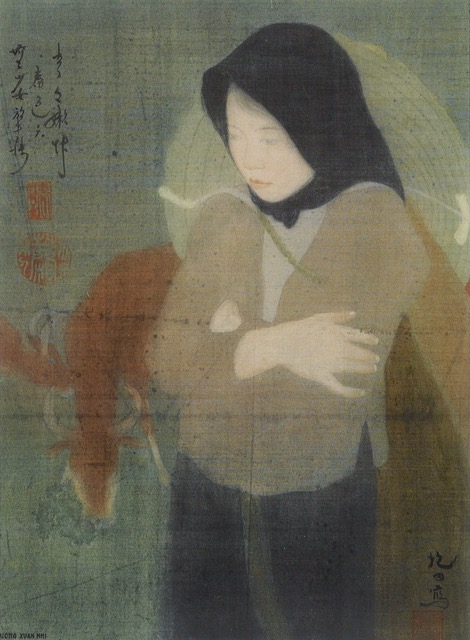Luong Xuan Nhi « The Little Cowherd » 1937 Or What Is The Use Of Holding The Sun?
This gouache and ink on silk was painted after the artist had already made a charcoal sketch in preparation in 1936, a year before receiving his diploma from the École des Beaux Arts of Indochina (in the 8th graduating class with, among others, Tôn Thât Dao and Lê Yên). The sketch is reproduced in Luong Xuan Nhi, A Collection of paintings and Graphics, published in Hanoi in 2003, p. 79.
In 1937, the completed silk painting, entitled “La Petite Gardienne de Buffle” (The Little Cowherd) and featured here, was presented, in Hanoi, at the SADEAI, or the Société Annamite d’Encouragement à l’Art et à l’Industrie (Annamite Association for the Encouragement of Art and Industry), which bestowed upon the artist the special Prize. Later that year, this silk painting was exhibited at “L’Exposition Universelle” (the World Exhibition) in Paris, then sold via the AGINDO (Economic Agency of Indochina).

It is the classic trajectory for the Vietnamese pictorial production of the time: works are painted in the wake of the College of Fine Arts of Hanoi, exhibited and awarded there, then sent to France in prestigious exhibitions to attract the attention of collectors-buyers. We cannot stress enough the considerable effort in promoting and selling this art offered by the colonial authorities and also by the French national authorities.
The Little Cowherd is a demonstration of Luong Xuan Nhi’s faithfulness to the world of “poetic realism” he held onto for a long time. In this work, Luong Xuan Nhi describes and magnifies what he considers to be the heart of Vietnamese soul; like Nguyen Phan Chanh who depicts the traditional and often modest activities of everyday life. This painting echoes other similar representations of groundbreaking works previously produced by Nguyen Phan Chanh such as “The Vegetable Washer”, “The O An Quan Players”, and “The Meal”, among others, all executed in 1931.
Luong Xuan Nhi’s use of tones of green and brown gouache, of black ink on silk enhances the common people, as they appear graceful and admirable in their devotion to their daily task.
The young girl has her arms crossed over her chest, her slender hands and her face barely marked, diaphanous, showing a gentle beauty that is normally incompatible with the usual effects of her work. The beast, at the back left, seems peaceful. The painter offers all his talent to this pensive but energetic young girl. Here Luong Xuan Nhi, faithful to the ideas of Tu Luc Van Doan – which we have already developed – demonstrate his certainty that the peasant class, with neglected quality, must be promoted and encouraged. Yet the solution is not so obvious.
Later he will approach the Vietnamese Communist Party. There is no need to recall the ambiguities of the party’s membership at such times… an overt nationalism that may have masked the Marxist-Leninist ideology. But it’s a fact: Luong Xuan Nhi will become an official artist. His work will suffer greatly.
An artist is a visionary, not a follower and it is enough to refer to the book that I mentioned above to be convinced of the loss of talent of the painter beyond the 40s. Some of his paintings illustrated here lack grace and inspiration. He is not unique: the example of Nguyen Phan Chanh among others can confirm it. Whereas the years 25-45 were “the golden age” of painting in Vietnam, as much the “left for France” (Vu Cao Dam, Le Pho, Mai Thu, Le Thi Luu…) will keep their artistic level, the period 45-65 remains poor in Vietnam.
The writing is interesting. We can read:
• Upper left (from right to left, in Chinese characters):
- “Green, green grass” (line 1. Notice the double “green”: it is common to see this in traditional Chinese poem in order to emphasize the green)
- “In the spring” (line 2, here the spring of 1937)
- “Young girl herding the cow” (line 3, title of the painting)
• Lower right (in Chinese characters):
- “Signed by Bao Ri”
(This is probably the artist’s pen name. Bao Ri means “holding the sun” in Chinese).
• Lower left (in romanized letters):
- “Luong Xuan Nhi”
The multiple seals are those used by the painter.
The subject is classic for Luong Xuan Nhi. Fresh in its conception, the painting nevertheless lacks a certain grace. Once again, adherence to Chinese culture by adopting a careful writing with a real meaning questions.
It will remain in vain. In this year 1937, so fundamental in Vietnamese painting, the real problem of meaning arises. Painting, yes, but for whom and why?
To hold the sun, of course, but to illuminate what?
Jean-François Hubert